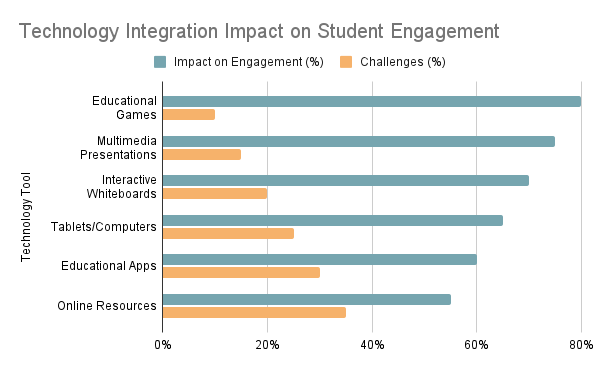Academic Action Research
Research Title:
Investigating the Impact of Technology Integration on Student Engagement in Middle School Classrooms
Author:
[Your Name]
Institution:
[University Name], [University Address]
Date: July 25, 2054
Abstract
This research explores how integrating technology into middle school classrooms affects student engagement. It involves analyzing classroom observations and student surveys to determine the impact of various technological tools on learning outcomes.
1. Introduction
1.1 Background
In recent years, educational technology has become increasingly prevalent in schools. This study examines how different types of technology influence student participation and interest in classroom activities.
1.2 Research Problem
Despite widespread adoption, there is limited empirical evidence on the effectiveness of technology integration in enhancing student engagement at the middle school level.
1.3 Purpose of the Study
The study aims to evaluate the impact of technology on student engagement and to identify best practices for effective implementation in middle school classrooms.
2. Literature Review
The literature review covers previous studies on technology in education, highlighting the benefits and challenges associated with its use. Key areas include improvements in interactive learning, student motivation, and the obstacles to technology adoption.
3. Research Methodology
3.1 Research Design
A mixed-methods approach was used, combining quantitative data from student surveys with qualitative data from classroom observations.
3.2 Data Collection
Data were collected through anonymous student surveys and observations of technology use in classrooms over a six-month period.
3.3 Data Analysis
Quantitative data were analyzed using statistical software to identify trends, while qualitative data were examined through thematic analysis to understand the context of student interactions with technology.
4. Findings
The research found that technology integration generally increased student engagement, with interactive tools such as educational games and multimedia presentations having the most significant impact. However, challenges such as technical issues and uneven access to devices were also noted.

5. Discussion
5.1 Interpretation of Findings
The findings suggest that technology can positively influence student engagement when used effectively. Teachers’ familiarity with technology and access to resources are crucial for successful implementation.
5.2 Limitations
The study faced limitations, including a small sample size and variability in technology access among students, which may affect the generalizability of the results.
6. Conclusion
The study concludes that integrating technology can enhance student engagement but requires careful planning and support. Future research should explore long-term impacts and strategies for overcoming implementation challenges.
References
Smith, J. (2053). Technology in Education: A Review. Educational Journal, 45(2), 123-135.
Johnson, L. (2052). The Effects of Interactive Learning Tools on Student Engagement. Journal of Educational Research, 56(4), 789-802.
Appendices
Appendix A: Survey Questionnaire
Appendix B: Classroom Observation Checklist
Appendix C: Data Tables and Graphs

















































